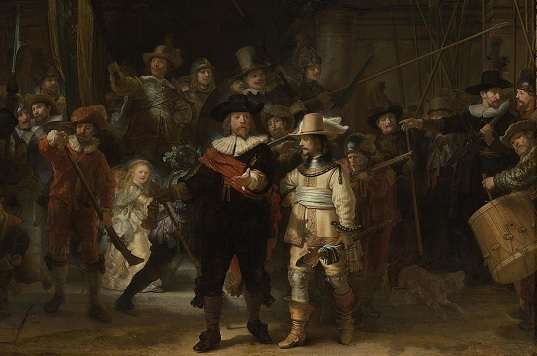
Introduction Of Famous Rembrandt Paintings:
Famous Rembrandt Paintings, In the vast and awe-inspiring world of art, few names shine as brightly as Rembrandt Harmenszoon van Rijn. Renowned for his exceptional talent and mastery of the Dutch Golden Age, Rembrandt left an indelible mark on the art world through his captivating paintings. This article delves into the brilliance of Rembrandt’s work, exploring some of his most famous paintings and the stories they tell.
The Artistic Genius of Rembrandt.
- The Night Watch (1642):
One of Rembrandt’s most iconic and celebrated works is “The Night Watch.” This colossal masterpiece, also known as “Militia Company of District II under the Command of Captain Frans Banninck Cocq,” depicts a group portrait of a militia company. With its ingenious use of light and shadow, the painting captures the attention of viewers, drawing them into the scene’s vibrant energy and dramatic movement.
- The Anatomy Lesson of Dr. Nicolaes Tulp (1632):
In “The Anatomy Lesson of Dr. Nicolaes Tulp,” Rembrandt showcases his skill in portraying human anatomy. This painting immortalizes a public dissection led by Dr. Tulp, a prominent Amsterdam physician. Rembrandt’s attention to detail and his ability to render the human form with astounding realism make this piece a true artistic gem.
Rembrandt’s Passion for Portraits.
- Self-Portrait with Two Circles (c. 1665-1669):
Throughout his life, Rembrandt painted numerous self-portraits, each reflecting different stages of his life and emotional depth. “Self-Portrait with Two Circles” is a striking example, showcasing the artist’s mastery in capturing his own likeness and evoking emotions through his expressive eyes.
- Portrait of Hendrickje Stoffels (1654):
In this captivating portrait, Rembrandt immortalizes Hendrickje Stoffels, his beloved companion, and muse. The painting exudes intimacy and tenderness, emphasizing Rembrandt’s ability to convey both physical beauty and emotional depth in his subjects.
The Enigmatic Beauty of Rembrandt’s Landscapes.
- Landscape with the Rest on the Flight into Egypt (1647):
While primarily known for his portraits and historical scenes, Rembrandt’s landscape paintings demonstrate a unique mastery of the genre. “Landscape with the Rest on the Flight into Egypt” is a testament to his ability to infuse nature with emotional resonance, making the scenery an integral part of the storytelling.
- The Windmill (1641):
“The Windmill” is a captivating landscape painting that showcases Rembrandt’s keen observation of natural elements. With its play of light and shadow, the artwork transports viewers to the serene Dutch countryside, capturing the essence of rural life during the artist’s time.
The Profound Narratives in Historical Paintings.
- The Return of the Prodigal Son (1669)
“The Return of the Prodigal Son”(Read more) is a deeply moving portrayal of the Biblical parable. Rembrandt’s emotional depth shines through in the depiction of the father’s forgiveness and the son’s repentance, creating a timeless piece that resonates with viewers on a spiritual level.
- The Jewish Bride (c. 1665-1669):
“The Jewish Bride” is an enigmatic painting that has sparked debates among art enthusiasts for centuries. The piece’s ambiguity allows viewers to interpret the scene differently, making it an intriguing and thought-provoking work of art.
Rembrandt’s Lasting Legacy:
Rembrandt’s brilliance as an artist transcends time, leaving an indelible legacy that continues to inspire generations of artists and art enthusiasts alike. His ability to breathe life into his subjects, evoke emotions through his brushstrokes, and craft intricate narratives sets him apart as one of the most exceptional painters in history.
Conclusion:
In the world of art, few artists have achieved the level of fame and recognition that Rembrandt has. His timeless paintings, from “The Night Watch” to “The Jewish Bride,” continue to mesmerize and captivate audiences worldwide. Through his profound understanding of light, shadow, and human emotion, Rembrandt has secured a place in the annals of art history that will forever remain unparalleled.
FAQs:
- What is Rembrandt’s most famous painting? Rembrandt’s most famous painting is “The Night Watch,” a monumental masterpiece that captures a militia company in action.
- How many self-portraits did Rembrandt paint? Rembrandt created around 100 self-portraits, providing a fascinating glimpse into his life and artistic journey.
- Did Rembrandt paint landscapes? Yes, although renowned for his portraits, Rembrandt also painted landscapes that showcased his exceptional skills as an artist.
- What makes “The Return of the Prodigal Son” special? “The Return of the Prodigal Son” is renowned for its emotional depth and spiritual resonance, making it one of Rembrandt’s most powerful works.
- How has Rembrandt’s legacy influenced modern art? Rembrandt’s innovative techniques and profound storytelling have inspired countless artists and continue to shape the art world today.
